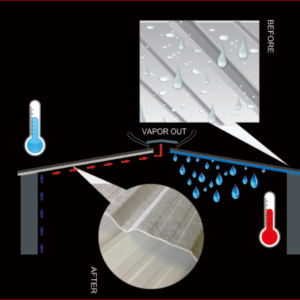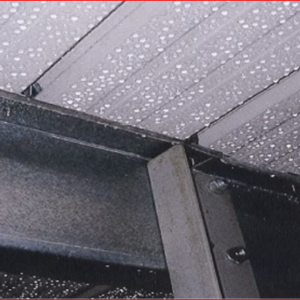

Metal buildings are great in many ways. They’re easy and inexpensive to assemble, they handle severe weather well, and they need very little maintenance to keep their appearance or their functionality. That said, they also experience a few problems that other buildings don’t see as often. The biggest of these is condensation and water damage.
Condensation is a bigger problem in steel buildings for a few reasons. First, because many metal buildings are uninsulated, condensation forms more easily in them than in other building types. The cool metal surface makes water vapor collect on the roof and walls much more readily than in a concrete or wooden structure. Also, because steel rusts, condensation can lead to problems both with the structure and the appearance of your building.
There are a few common causes of condensation problems in steel buildings. Understanding why your building is experiencing condensation issues is the first step towards solving the problem.
Lack of Insulation
When there’s a big temperature difference between the inside and outside, condensation will form on your walls and ceiling. Water will always condense on a cooler surface, and metal walls or roofs are the perfect place for it to collect. Over time this can lead to rust, mold, and pooling water that can erode your foundations.
The most frequent cause of condensation problems is that the walls and roof aren’t insulated. This puts the cooler surface of the metal up against warmer, more humid air, and allows water vapor to condense on it easily. Fortunately this problem is relatively easy to solve. Insulation can be added to almost any metal building interior, which in turn reduces condensation and also helps regulate the interior temperature of the building. Whether you have a farm building, a shed, or a metal garage, it would probably benefit from being insulated.
Improper Construction
Another common problem that leads to condensation is improper construction of the building, specifically the concrete pad that provides the building’s foundation. In many cases, building owners or the contractors putting the structure together want to do it as quickly as possible, so they will either assemble the building while the concrete is still curing or they will pour a concrete pad into the floor after the building is finished.
In both cases, this can cause condensation problems. Why? Simple: as concrete cures, the water used to keep it fluid evaporates, leaving behind the solid form. But the evaporated water still has to go somewhere, and if there is a building enclosing the space over the concrete then the water will condense on the interior surfaces. This can also cause the water to drip down and pool on the still-curing concrete, which creates even bigger problems.
The solution to this issue is simple. Either fully prepare the concrete surface before constructing the building over it, or (if you must do both at the same time) leave a panel off the walls or roof while the concrete finishes curing. If you have a smaller building, you can also leave a door or window open – just keep in mind that you want to exchange as much air as possible. By leaving some open space for water vapor to escape, you’ll ensure that the concrete cures properly and there will be no condensation issues.
Lack of Ventilation
If you use your steel building as a workshop, shed, or for animal shelter and you’re experiencing condensation problems, one likely cause is a lack of proper ventilation. The presence of humans or animals in a metal building is enough to raise the internal temperature by several degrees. Plus, breathing air in and out, sweating, and urination from horses or cows can cause a significant amount of humidity inside your building. This humid air will condense on the steel walls or roof and cause problems like mildew, mold, and rust.
Ventilation problems can be solved by adding vents, openable windows, and fans to your building in order to promote air movement and exchange. There are a number of ventilation options for metal buildings, including wall and roof louvers, openable vents with bird screens, traditional and sliding windows, and extractor fans. All of these solutions will help keep the interior of your building less humid and decrease condensation. You can also use dehumidifiers in conjunction with these other methods, but keep in mind they are more expensive to run and must have proper drainage (or be emptied regularly).
Insulation Problems
A special concern when dealing with insulated buildings is when the insulation itself is exposed to condensation. Buildings that are improperly insulated can experience even bigger problems than those that aren’t insulated at all. For instance, when fiberglass or blown insulation is exposed to water, it absorbs it and quickly grows mildew or mold, leading to odor and problems with rot, allergies, or illness.
Most insulation problems occur because the insulation was not properly sealed from the outside air. In a metal building, it’s especially important that you seal the top and bottom spaces with vinyl backing or a vapor barrier so you can keep humid air out of the insulated space. This will also prevent unwanted heat transfer, which in turn makes the insulation more efficient.
If you want to know more about keeping your metal building in top shape, contact us today for details.
